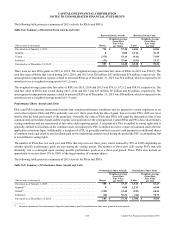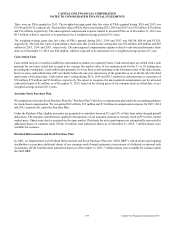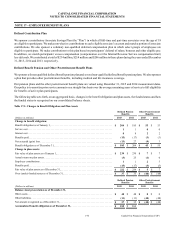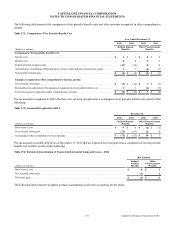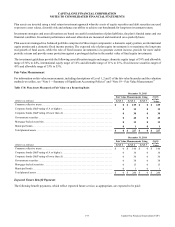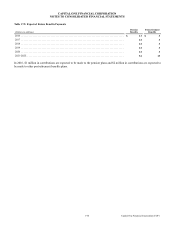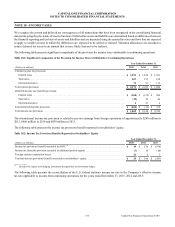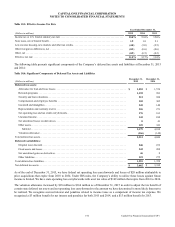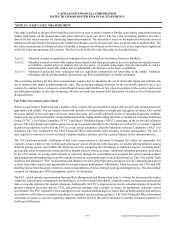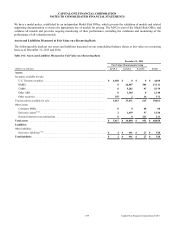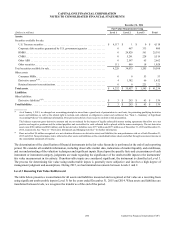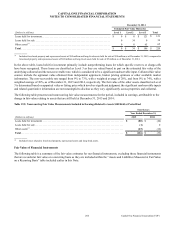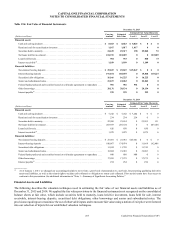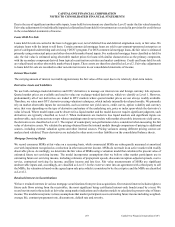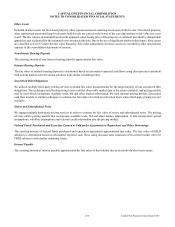Capital One 2015 Annual Report Download - page 217
Download and view the complete annual report
Please find page 217 of the 2015 Capital One annual report below. You can navigate through the pages in the report by either clicking on the pages listed below, or by using the keyword search tool below to find specific information within the annual report.
CAPITAL ONE FINANCIAL CORPORATION
NOTES TO CONSOLIDATED FINANCIAL STATEMENTS
198 Capital One Financial Corporation (COF)
NOTE 19—FAIR VALUE MEASUREMENT
Fair value is defined as the price that would be received for an asset or paid to transfer a liability in an orderly transaction between
market participants on the measurement date (also referred to as an exit price). The fair value accounting guidance provides a
three-level fair value hierarchy for classifying financial instruments. This hierarchy is based on the markets in which the assets or
liabilities trade and whether the inputs to the valuation techniques used to measure fair value are observable or unobservable. The
fair value measurement of a financial asset or liability is assigned a level based on the lowest level of any input that is significant
to the fair value measurement in its entirety. The three levels of the fair value hierarchy are described below:
Level 1: Valuation is based on quoted prices (unadjusted) in active markets for identical assets or liabilities.
Level 2:
Valuation is based on observable market-based inputs, other than quoted prices in active markets for identical assets
or liabilities, quoted prices in markets that are not active, or models using inputs that are observable or can be
corroborated by observable market data of substantially the full term of the assets or liabilities.
Level 3: Valuation is generated from techniques that use significant assumptions not observable in the market. Valuation
techniques include pricing models, discounted cash flow methodologies or similar techniques.
The accounting guidance for fair value measurements requires that we maximize the use of observable inputs and minimize the
use of unobservable inputs in determining fair value. The accounting guidance provides for the irrevocable option to elect, on a
contract-by-contract basis, to measure certain financial assets and liabilities at fair value at inception of the contract and record
any subsequent changes in fair value in earnings. We have not made any material fair value option elections as of or for the periods
disclosed herein.
Fair Value Governance and Control
We have a governance framework and a number of key controls that are intended to ensure that our fair value measurements are
appropriate and reliable. Our governance framework provides for independent oversight and segregation of duties. Our control
processes include review and approval of new transaction types, price verification and review of valuation judgments, methods,
models, process controls and results. Groups independent of our trading and investing functions, including our Corporate Valuations
Group (“CVG”), Fair Value Committee (“FVC”) and Model Validation Group (“MVG”), participate in the review and validation
process. The fair valuation governance process is set up in a manner that allows the Chairperson of the FVC to escalate valuation
disputes that cannot be resolved by the FVC to a more senior committee called the Valuations Advisory Committee (“VAC”) for
resolution. The VAC is chaired by the Chief Financial Officer and includes other members of senior management. The VAC is
only required to convene to review escalated valuation disputes and may meet for a general update on the valuation process.
The CVG performs periodic verification of fair value measurements to determine if assigned fair values are reasonable. For
example, in cases where we rely on third-party pricing services to obtain fair value measures, we analyze pricing variances among
different pricing sources and validate the final price used by comparing the information to additional sources, including dealer
pricing indications in transaction results and other internal sources, where necessary. Additional validation procedures performed
by the CVG include reviewing (either directly or indirectly through the reasonableness of assigned fair values) valuation inputs
and assumptions and monitoring acceptable variances between recommended prices and validation prices. The CVG and the Trade
Analytics and Valuation (“TAV”) team perform due diligence reviews of the third-party pricing services by comparing their prices
to those from other sources and periodically reviewing research publications. Additionally, when necessary, the CVG and TAV
challenge prices from third-party vendors to ensure reasonableness of prices through a pricing challenge process. This may include
a request for transparency of the assumptions used by the third party.
The FVC, which includes representation from our Risk Management and Finance functions, is a forum for discussing fair market
valuations, related inputs, assumptions, methodologies, as well as variance thresholds, valuation control environments and material
risks or concerns related to fair market valuations. Additionally, the FVC is empowered to resolve valuation disputes between the
primary valuation providers and the CVG, and provides guidance and oversight to ensure an appropriate valuation control
environment. The FVC regularly reviews and approves our valuation methodologies to ensure that our methodologies and practices
are consistent with industry standards and adhere to regulatory and accounting guidance. The Chief Financial Officer determines
when material issues or concerns regarding valuations shall be raised to the Audit Committee or another delegated committee of
the Board of Directors.


